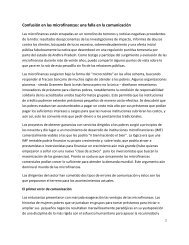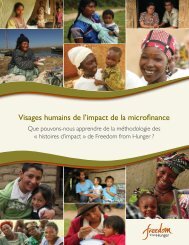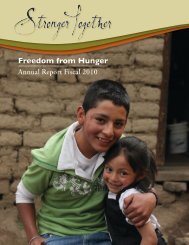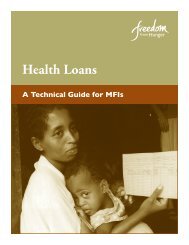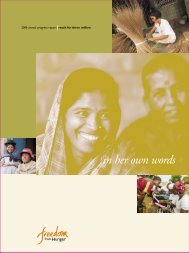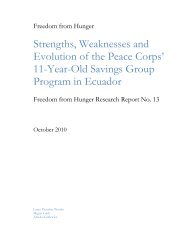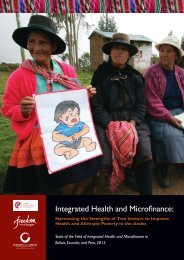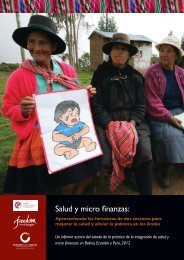history of meals for millions, soy, and freedom from ... - SoyInfo Center
history of meals for millions, soy, and freedom from ... - SoyInfo Center
history of meals for millions, soy, and freedom from ... - SoyInfo Center
You also want an ePaper? Increase the reach of your titles
YUMPU automatically turns print PDFs into web optimized ePapers that Google loves.
Box 1666), Santa Monica, Cali<strong>for</strong>nia 90406. Phone: 870-<br />
0451.<br />
254. Ch<strong>and</strong>rasekhara, M.R. 1974. Vegetable proteins <strong>for</strong><br />
combatting protein malnutrition in developing countries. In:<br />
Proceedings Fourth International Congress Food Science<br />
<strong>and</strong> Technology. Madrid, Spain: International Union <strong>of</strong><br />
Food Science & Technology. 6 vols. See vol. 5, p. 257-66.<br />
Held 23-27 Sept. 1974 at Madrid, Spain. [14 ref]<br />
• Summary: Edible peanut flour is used in India to help the<br />
hungry <strong>and</strong> malnourished. Bal Ahar (“children’s food”) is a<br />
dry blend <strong>of</strong> flours <strong>from</strong> cereals, oil seed <strong>meals</strong>, <strong>and</strong> pulses;<br />
several <strong>for</strong>mulas have been used, including one (Formula<br />
IV) containing 15% <strong>soy</strong>a flour. Miltone, a milk-like<br />
preparation containing peanut protein isolate, has been<br />
produced at the Bangalore Dairy <strong>for</strong> the past six years;<br />
production has increased <strong>from</strong> 5,180 liters in 1966-67 to<br />
1,047,797 liters in 1973-74.<br />
Aflatoxin is a problem in peanut meal. In India, edible<br />
peanut protein concentrate is mostly used in child feeding<br />
programmes. Soya flour has recently been introduced,<br />
however large quantities are not yet available <strong>for</strong> feeding<br />
programmes. Yet the CARE organization in India is<br />
importing CSM (85% bulgar wheat flour <strong>and</strong> 15% solvent<br />
extracted <strong>soy</strong>a flour) as well as <strong>soy</strong>a flour, <strong>and</strong> using both in<br />
its programmes. Sesame flour is still in the developmental<br />
stage. A high protein food named India Multipurpose Food<br />
was used in school feeding programmes as a supplement to<br />
staple food; it was a blend <strong>of</strong> 75 parts edible peanut flour<br />
<strong>and</strong> 25 parts <strong>of</strong> chick pea flour–<strong>for</strong>tified with vitamins <strong>and</strong><br />
minerals. Address: Project Administrator <strong>and</strong> Coordinator,<br />
Miltone Project, (Ministry <strong>of</strong> Agriculture) Bangalore Dairy,<br />
Bangalore–560029, India. Present address: 53, 13 Cross<br />
Road, Malleswaram, Bangalore, 560003, India.<br />
255. Silva, C.C. de. 1974. The Ceylon Meals <strong>for</strong> Millions<br />
Foundation <strong>and</strong> the Poshanaya Exhibition, February 1974.<br />
MEALS FOR MILLIONS, SOY, AND FREEDOM FROM HUNGER 111<br />
© Copyright Soyinfo <strong>Center</strong> 2011<br />
Paper presented in Ceylon. 4 p. Undated. Unpublished<br />
manuscript.<br />
• Summary: In August 1971 the Ceylon MFM Foundation<br />
started a vigorous campaign to popularize the cultivation <strong>of</strong><br />
<strong>soy</strong>a on a large scale; “a memor<strong>and</strong>um was submitted to the<br />
Minister <strong>of</strong> Agriculture <strong>and</strong> L<strong>and</strong>s. A feasibility report was<br />
prepared <strong>and</strong> given to the Ministry, which was followed by<br />
an interview with the Secretary <strong>of</strong> the Ministry <strong>and</strong> a visit to<br />
the Agricultural Research Station at Maha Illuppalama...<br />
arrangements were made to have a public seminar on <strong>soy</strong>a<br />
cultivation as well as utilization in 1972 <strong>and</strong> 1973, but this<br />
had to be postponed several times due to lack <strong>of</strong> planting<br />
material [<strong>soy</strong>beans]. In September, 1973, however, we<br />
decided not to have the Seminar.<br />
“The Prime Minister inaugurated the Food Production<br />
War on 20th September 1973 with the appointment <strong>of</strong> 22<br />
Political Authorities <strong>and</strong> it was decided to launch a<br />
campaign <strong>for</strong> the cultivation <strong>of</strong> subsidiary crops, which<br />
included cereal, pulses, roots <strong>and</strong> tuber crops on an isl<strong>and</strong>wide<br />
basis, with a special co-ordinating Secretariat <strong>of</strong> the<br />
Planning Ministry at its helm.”<br />
The exhibition was sponsored <strong>and</strong> organized by the Sri<br />
Lanka MFM Foundation. Dr. Walter Fern<strong>and</strong>o is director <strong>of</strong><br />
the Soya Bean Project <strong>of</strong> the Ministry <strong>of</strong> Agriculture.<br />
Address: Pr<strong>of</strong>. de Silva is President, Sri Lanka Meals <strong>for</strong><br />
Millions Foundation.<br />
256. Meals <strong>for</strong> Millions Foundation. 1975. The question is<br />
not whether we will help, but how [Annual report 1974].<br />
Santa Monica, Cali<strong>for</strong>nia: MFM Foundation. 6 p. 28 cm.<br />
• Summary: Mark M. Sterner is Executive Director. Cover<br />
is as if this were one issue <strong>of</strong> the Meals <strong>for</strong> Millions<br />
Newsletter. In the upper left corner is MFM’s logo (slightly<br />
redesigned) <strong>of</strong> a plant growing out <strong>of</strong> mounded soil in a<br />
bowl which is half <strong>of</strong> a globe. Below that: “Self-help <strong>for</strong> a<br />
hungry world.” The pages are unnumbered.<br />
Contents: MFM provides the “how” in Korean<br />
beverage plant (The plant began regular operation in July<br />
1974, producing Super D <strong>soy</strong> beverage, bottled <strong>and</strong><br />
inexpensive enough to compete with s<strong>of</strong>t drinks. Mr. Jong-<br />
Yoon Chun is president <strong>of</strong> Sam Yang Foods). MFM sends<br />
seeding machine to Ecuador <strong>for</strong> planting <strong>soy</strong>beans. MFM<br />
moves into new self-help project in Midwest (Bootheel,<br />
Missouri). MFM’s International Institute <strong>of</strong> Protein Food<br />
Technology (Patricia Stevens, program director, says “the<br />
course will bear the <strong>of</strong>ficial title <strong>of</strong> ‘Low-Cost, High Protein<br />
Foods’”). Tennessee. Ug<strong>and</strong>a. New Mexico. Shipments <strong>of</strong><br />
MPF to drought victims in countries bordering the rainless<br />
Sahara.<br />
How MFM spent its donor dollars in 1973. Income:<br />
$486,544 (up 28.9% <strong>from</strong> last year) <strong>of</strong> which 3.4% used <strong>for</strong><br />
general administration, 9.5% <strong>for</strong> public relations, 17.5% <strong>for</strong><br />
fund raising, <strong>and</strong> 69% <strong>for</strong> programs.



